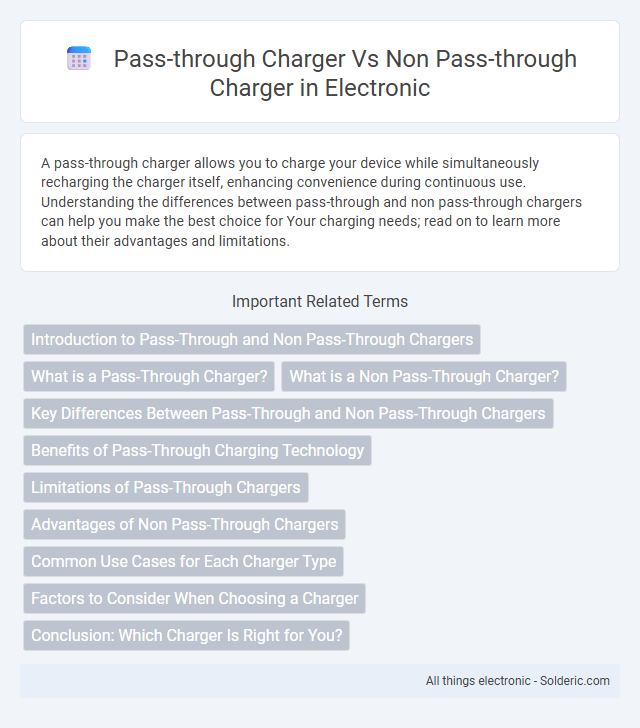A pass-through charger allows you to charge your device while simultaneously recharging the charger itself, enhancing convenience during continuous use. Understanding the differences between pass-through and non pass-through chargers can help you make the best choice for Your charging needs; read on to learn more about their advantages and limitations.
Comparison Table
| Feature | Pass-Through Charger | Non Pass-Through Charger |
|---|---|---|
| Charging Capability | Charges device while recharging itself | Charges device only after fully charged |
| Convenience | Allows simultaneous charging and use | No simultaneous charging; device unavailable during recharge |
| Use Cases | Ideal for continuous power needs, travel, and emergencies | Suitable for standard charging routines |
| Battery Life Impact | May reduce battery longevity due to constant charging cycles | Less impact, as charging is sequential |
| Price | Generally higher due to advanced technology | Usually lower cost |
Introduction to Pass-Through and Non Pass-Through Chargers
Pass-through chargers allow you to charge your device while simultaneously recharging the charger itself, providing uninterrupted power supply and convenience for continuous use. Non pass-through chargers require the device to be disconnected before the charger can be recharged, which can delay usage and reduce efficiency. Understanding the differences between pass-through and non pass-through chargers helps optimize charging strategies for your devices.
What is a Pass-Through Charger?
A pass-through charger allows you to charge a device while simultaneously supplying power to another device or system, maintaining continuous power flow without interruption. This type of charger is particularly useful for maintaining device operation during battery replacement or system upgrades. Your ability to use multiple devices without downtime is enhanced by the seamless power management of pass-through chargers.
What is a Non Pass-Through Charger?
A Non Pass-Through Charger is a charging device that cannot simultaneously power a connected device and recharge its own internal battery. It functions by either charging the device or recharging its battery, but not both at the same time, which may limit convenience during extended use. This contrasts with pass-through chargers that provide continuous power to the device while replenishing their own battery.
Key Differences Between Pass-Through and Non Pass-Through Chargers
Pass-through chargers allow simultaneous charging of the power bank and connected devices, offering continuous power supply without interruptions, ideal for extended use and efficiency. Non pass-through chargers only charge the power bank first, requiring disconnection before using stored power to charge devices, which can be less convenient during multitasking. The key difference lies in the functionality and user experience, with pass-through models providing more flexibility for on-the-go charging needs.
Benefits of Pass-Through Charging Technology
Pass-through charging technology allows simultaneous charging of a device and an external battery pack, ensuring uninterrupted power supply and convenience for prolonged usage. This feature minimizes downtime by enabling continuous device operation while charging, especially beneficial for smartphones, laptops, and gaming devices. It also helps maintain battery health by preventing complete discharge during use, extending the overall lifespan of both the device and the power bank.
Limitations of Pass-Through Chargers
Pass-through chargers allow simultaneous use of the device while charging, but they often suffer from slower charging speeds compared to non pass-through chargers due to power distribution inefficiencies. They may also generate excess heat during use, which can reduce battery lifespan and pose safety risks. Your device's charging time and battery health can be compromised when relying on pass-through chargers, especially under heavy usage.
Advantages of Non Pass-Through Chargers
Non pass-through chargers provide enhanced safety by isolating charging and discharging processes, which reduces the risk of electrical faults and overheating. They offer better battery longevity because they prevent continuous power flow that can degrade battery cells during simultaneous charging and usage. Your device benefits from more reliable performance and consistent power delivery without the interference common in pass-through chargers.
Common Use Cases for Each Charger Type
Pass-through chargers are ideal for scenarios where you need to charge your device while simultaneously using it, such as vaping or powering portable electronics without interruption. Non pass-through chargers are better suited for dedicated charging sessions where device safety and battery preservation are paramount, commonly used for removable batteries or devices not in active use. Your choice depends on whether continuous device operation during charging is a priority or if optimized battery maintenance is more important.
Factors to Consider When Choosing a Charger
Pass-through chargers allow simultaneous charging of the device and the charger's battery, making them ideal for continuous use without interruption. Non pass-through chargers typically charge the battery first before powering the device, which can lead to longer charging times. Key factors to consider include charging speed, device compatibility, safety features like overcharge protection, and convenience based on usage patterns.
Conclusion: Which Charger Is Right for You?
A pass-through charger allows you to charge your device while simultaneously charging the charger itself, offering convenience and uninterrupted use. Non pass-through chargers require the device to disconnect during the charger's recharge, which can slow your workflow or cause downtime. Consider a pass-through charger if your priority is continuous device usage; otherwise, a non pass-through charger may suffice for less demanding needs.
Pass-through charger vs non pass-through charger Infographic

 solderic.com
solderic.com